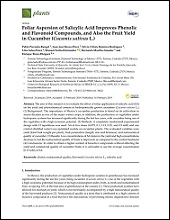Mostrar el registro sencillo del ítem
Foliar Aspersion of Salicylic Acid Improves Phenolic and Flavonoid Compounds, and Also the Fruit Yield in Cucumber (Cucumis sativus L.)
| dc.contributor.author | Preciado Rangel, Pablo | |
| dc.contributor.author | REYES PEREZ, JUAN JOSE | |
| dc.contributor.author | RAMIREZ RODRIGUEZ, SILVIA CITLALY | |
| dc.contributor.author | Salas Pérez, Lilia | |
| dc.contributor.author | Fortis Hernández, Manuel | |
| dc.contributor.author | Murillo Amador, Bernardo | |
| dc.contributor.author | TROYO DIEGUEZ, ENRIQUE | |
| dc.date.issued | 2019 | |
| dc.identifier | https://cibnor.repositorioinstitucional.mx/jspui/handle/1001/1630 | |
| dc.identifier.issn | 2223-7747 | |
| dc.identifier.other | 10.3390/plants8020044 | |
| dc.identifier.uri | http://dspace.cibnor.mx:8080/handle/123456789/2966 | |
| dc.format | es | |
| dc.language.iso | eng | es |
| dc.publisher | Multidisciplinary Digital Publishing Institute | es |
| dc.rights | Acceso abierto | es |
| dc.source | Plants | |
| dc.subject | elicitor, nutraceutical quality, flavonoid, Cucumis sativus L., salicylic acid | es |
| dc.subject.classification | DESARROLLO VEGETAL | es |
| dc.title | Foliar Aspersion of Salicylic Acid Improves Phenolic and Flavonoid Compounds, and Also the Fruit Yield in Cucumber (Cucumis sativus L.) | es |
| dc.type | article | es |
| dc.description.abstracten | "The aim of this research is to evaluate the effect of foliar application of salicylic acid (SA) on the yield and phytochemical content in hydroponically grown cucumber (Cucumis sativus L.). (1) Background: The importance of Mexico’s cucumber production is based on its cultivation in recent decades as one of the major winter crops; in addition, the production of vegetables under hydroponic systems has increased significantly during the last few years, with cucumber being one of the vegetables with a high economic potential. (2) Methods: A completely randomized experimental design with 15 repetitions was used. SA at five doses (0.075, 0.1, 0.15, 0.25, and 0.5 mM) and one control (distilled water) was sprinkled weekly on cucumber plants. The evaluated variables were yield (total fruit weight per plant), fruit parameters (length, size and firmness), and nutraceutical quality of cucumber. (3) Results: Low concentrations of SA improve the yield and high concentrations decrease it, but the nutraceutical quality of fruits is improved, as compared to the control treatment. (4) Conclusions: In order to obtain a higher content of bioactive compounds without affecting the yield and commercial quality of cucumber fruits, it is advisable to use the average concentration (0.15 mM) of SA." | es |

